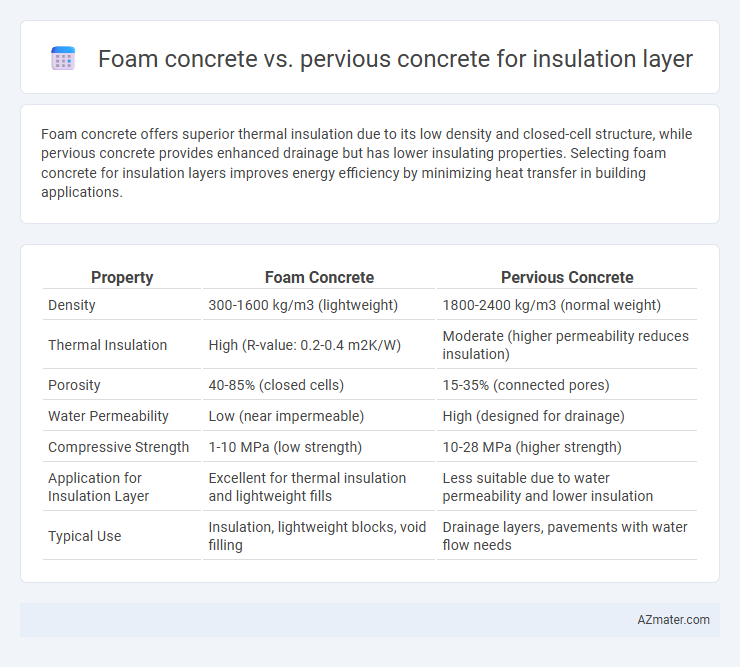Foam concrete offers superior thermal insulation due to its low density and closed-cell structure, while pervious concrete provides enhanced drainage but has lower insulating properties. Selecting foam concrete for insulation layers improves energy efficiency by minimizing heat transfer in building applications.
Table of Comparison
| Property | Foam Concrete | Pervious Concrete |
|---|---|---|
| Density | 300-1600 kg/m3 (lightweight) | 1800-2400 kg/m3 (normal weight) |
| Thermal Insulation | High (R-value: 0.2-0.4 m2K/W) | Moderate (higher permeability reduces insulation) |
| Porosity | 40-85% (closed cells) | 15-35% (connected pores) |
| Water Permeability | Low (near impermeable) | High (designed for drainage) |
| Compressive Strength | 1-10 MPa (low strength) | 10-28 MPa (higher strength) |
| Application for Insulation Layer | Excellent for thermal insulation and lightweight fills | Less suitable due to water permeability and lower insulation |
| Typical Use | Insulation, lightweight blocks, void filling | Drainage layers, pavements with water flow needs |
Introduction to Foam Concrete and Pervious Concrete
Foam concrete is a lightweight, aerated material composed of cement, water, and foam, offering excellent thermal insulation due to its closed-cell structure that traps air. Pervious concrete, designed with high porosity, allows water infiltration and provides moderate insulation by reducing heat transfer through its interconnected voids. Both materials serve as effective insulation layers but differ in density, permeability, and thermal conductivity, influencing their suitability for specific construction applications.
Composition and Material Properties Comparison
Foam concrete consists of cement, water, and pre-formed foam, creating a lightweight, highly insulating material with low thermal conductivity and excellent sound absorption. Pervious concrete is formulated with cement, coarse aggregates, and little to no fine aggregates, resulting in a porous structure that promotes water permeability but has lower insulating properties. The closed-cell structure of foam concrete offers superior thermal insulation compared to the open-void network of pervious concrete, making it more effective as an insulation layer.
Thermal Insulation Performance
Foam concrete offers superior thermal insulation performance due to its low density and high air content, resulting in excellent heat resistance and reduced thermal conductivity. Pervious concrete, while beneficial for permeability and drainage, generally has higher thermal conductivity, making it less effective as an insulation layer. Foam concrete's cellular structure significantly enhances energy efficiency in building applications by minimizing heat transfer.
Structural Strength and Load-Bearing Capacity
Foam concrete offers lightweight insulation with lower density, resulting in reduced structural strength and limited load-bearing capacity compared to pervious concrete. Pervious concrete, with its higher density and interconnected void structure, provides enhanced structural strength and superior load-bearing capabilities while maintaining permeability. Selecting foam concrete favors thermal insulation efficiency, but pervious concrete supports greater load demands in structural applications.
Moisture Resistance and Permeability
Foam concrete offers superior moisture resistance due to its closed-cell structure, effectively limiting water absorption and enhancing thermal insulation performance. Pervious concrete, characterized by its high permeability and interconnected voids, excels in drainage but allows moisture passage, reducing its effectiveness as an insulation layer. Selecting foam concrete for insulation layers ensures better protection against moisture intrusion, while pervious concrete is more suited for applications requiring rapid water drainage.
Environmental Impact and Sustainability
Foam concrete offers enhanced thermal insulation with a lower density and reduced cement content, resulting in decreased carbon emissions during production compared to traditional concrete. Pervious concrete supports sustainability by promoting groundwater recharge and reducing stormwater runoff, but its insulation properties are generally less effective than foam concrete. Choosing foam concrete for insulation layers provides a balance of energy efficiency and lower environmental impact, while pervious concrete benefits ecological management and urban heat island mitigation.
Installation Methods and Application Techniques
Foam concrete installation requires mixing cement, water, and foam to create a lightweight, aerated material that is poured or pumped into place, offering excellent thermal insulation and soundproofing for floors and roofs. Pervious concrete involves preparing a mixture with little to no fine aggregates, allowing water permeability, and is typically applied using conventional pouring and screeding methods, mostly suited for drainage and surface runoff control rather than insulation. Application techniques for foam concrete emphasize controlled expansion and curing to optimize insulative properties, whereas pervious concrete focuses on maintaining porosity and structural integrity for effective water management.
Cost Efficiency and Economic Considerations
Foam concrete offers superior cost efficiency as an insulation layer due to its lightweight properties and lower raw material expenses compared to pervious concrete, which involves higher production costs linked to its porous structure and specialized aggregates. Foam concrete's thermal insulation performance reduces energy consumption, creating long-term economic benefits that outweigh initial installation costs. Pervious concrete, while beneficial for drainage, generally requires more maintenance and does not provide equivalent insulation value, making foam concrete the preferred option for cost-effective thermal insulation solutions.
Durability and Maintenance Requirements
Foam concrete offers superior thermal insulation with low density and excellent durability, resisting moisture and freeze-thaw cycles, making it ideal for long-term insulation layers with minimal maintenance. Pervious concrete, while beneficial for drainage and permeability, has a more porous structure that may reduce durability under freeze-thaw conditions and requires more frequent upkeep to prevent clogging and maintain performance. Choosing foam concrete ensures a robust, low-maintenance insulation layer, whereas pervious concrete demands regular cleaning and inspection to sustain its functional lifespan.
Best Use Cases: Choosing the Right Concrete for Insulation Layer
Foam concrete excels in thermal insulation due to its closed-cell structure, making it ideal for insulating roofs, floors, and walls where high thermal resistance is required. Pervious concrete, with its open-cell structure, provides drainage and breathability but offers lower insulation value, best suited for applications where water permeability and cooling effects are prioritized, such as parking lots and pavements. Selecting between foam and pervious concrete depends on balancing insulation needs with permeability requirements to optimize energy efficiency and site functionality.

Infographic: Foam concrete vs Pervious concrete for Insulation layer
 azmater.com
azmater.com